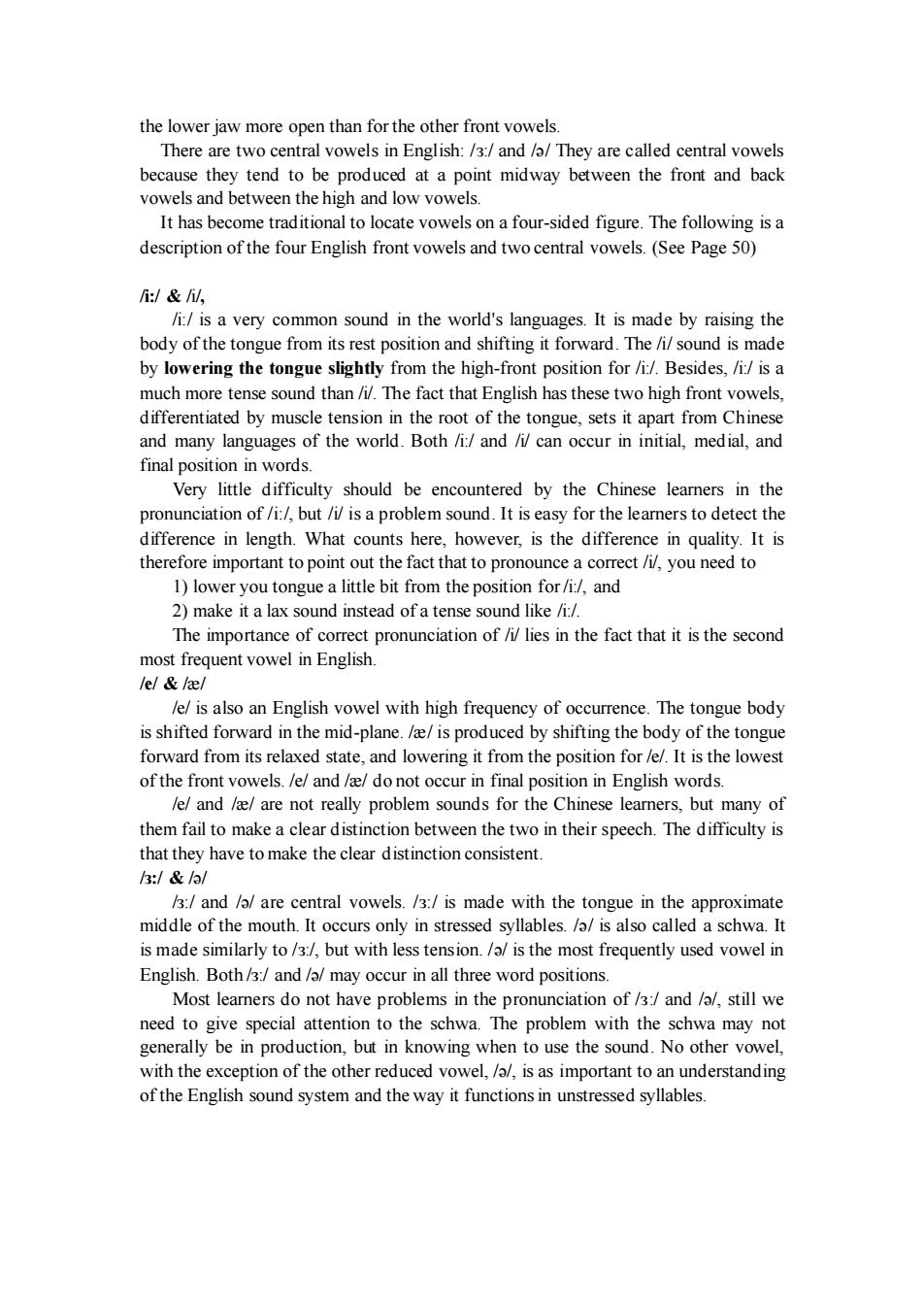正在加载图片...

the lower iaw more open than for the other front vowels Ther re two ntral vowels in English://and/They are called central vowels because they tend to be produced at a point midway between the front and back vowels and between the high and low vowels. It has become traditional to locate vowels on a four-sided figure.The following is a description of the four english front vowels and two central vowels.(See page 50) fi:/hil, /i:/is a very common sound in the world's languages.It is made by raising the body of the tongue from its rest position and shifting it forward.The /i/sound is made by lowering the tongue slightly from the high-front position for/i/.Besides,/i:/is a much more tense sound than/i/.The fact that English has these two high front vowels. differentiated by musce ension oot of the tongue,sets it apar fron and many languages of the world.Both/i/and /i/can occur in initial,medial,and final position in words. Very little difficulty should be encountered by the Chinese leamers in the pronunciation of/i:/,but/i/is a problem sound.It is easy for the learners to detect the however,is the diffe v.It is errtoo the factthattopnounmet you need to 1)lower you tongue a little bit from the position for/i:/,and 2)make it a lax sound instead of a tense sound like /i/. The importance of correct pronunciation of/i/lies in the fact that it is the second most frequent vowel in English. /e/is also an English vowel with high frequency of occurrence.The tongue body is shifted forward in the mid-plane./ae/is produced by shifting the body of the tongue forward from its relaxed state,and lowering it from the position for /e/.It is the lowest of the front vowels./e/and/a/do not occur in final position in English words. lel and ael are n bler sounds for the Chi es rs but many of them fail to make a clear distinction between the two in their speech.The difficulty is that they have to make the clear distinction consistent. :/&l /3:/and /a/are central vowels./3:/is made with the tongue in the approximate middle of the mouth.It occurs only in stressed syllables./a schwa.It is made simi arly to/but with less tension.is the most frequently used vowel in English.Both/:/and /a/may occur in all three word positions. Most learners do not have problems in the pronunciation of/3:/and /a/,still we need to give special attention to the schwa.The problem with the schwa may not generally be in production,but in knowing when to use the sound.No other vowel, of the ther el,lal,is a as important to a derstanding of the English sound system and the way it functions in unstressed syllables the lower jaw more open than for the other front vowels. There are two central vowels in English: /з:/ and /ə/ They are called central vowels because they tend to be produced at a point midway between the front and back vowels and between the high and low vowels. It has become traditional to locate vowels on a four-sided figure. The following is a description of the four English front vowels and two central vowels. (See Page 50) /i:/ & /i/, /i:/ is a very common sound in the world's languages. It is made by raising the body of the tongue from its rest position and shifting it forward. The /i/ sound is made by lowering the tongue slightly from the high-front position for /i:/. Besides, /i:/ is a much more tense sound than /i/. The fact that English has these two high front vowels, differentiated by muscle tension in the root of the tongue, sets it apart from Chinese and many languages of the world. Both /i:/ and /i/ can occur in initial, medial, and final position in words. Very little difficulty should be encountered by the Chinese learners in the pronunciation of /i:/, but /i/ is a problem sound. It is easy for the learners to detect the difference in length. What counts here, however, is the difference in quality. It is therefore important to point out the fact that to pronounce a correct /i/, you need to 1) lower you tongue a little bit from the position for /i:/, and 2) make it a lax sound instead of a tense sound like /i:/. The importance of correct pronunciation of /i/ lies in the fact that it is the second most frequent vowel in English. /e/ & /æ/ /e/ is also an English vowel with high frequency of occurrence. The tongue body is shifted forward in the mid-plane. /æ/ is produced by shifting the body of the tongue forward from its relaxed state, and lowering it from the position for /e/. It is the lowest of the front vowels. /e/ and /æ/ do not occur in final position in English words. /e/ and /æ/ are not really problem sounds for the Chinese learners, but many of them fail to make a clear distinction between the two in their speech. The difficulty is that they have to make the clear distinction consistent. /з:/ & /ə/ /з:/ and /ə/ are central vowels. /з:/ is made with the tongue in the approximate middle of the mouth. It occurs only in stressed syllables. /ə/ is also called a schwa. It is made similarly to /з:/, but with less tension. /ə/ is the most frequently used vowel in English. Both /з:/ and /ə/ may occur in all three word positions. Most learners do not have problems in the pronunciation of /з:/ and /ə/, still we need to give special attention to the schwa. The problem with the schwa may not generally be in production, but in knowing when to use the sound. No other vowel, with the exception of the other reduced vowel, /ə/, is as important to an understanding of the English sound system and the way it functions in unstressed syllables